Frigiliana
Watch our slideshow from Frigiliana:
Frigiliana is a very beautiful and unique village located high on the ridges of the Sierra Almijara mountain range. Being 300 meters above sea level, the village offers an incredible panoramic view of Nerja and the Mediterranean. This whitewashed village has won awards such as “the most beautiful village in Andalusia” from the Spanish tourism authority. Frigiliana is only 6 km north of Nerja and 50 km from Malaga.
Upon arriving in Frigiliana, it feels like you have traveled back in time. Narrow, steep cobblestone streets wind around the whitewashed houses. You can see wrought iron balconies filled with red geraniums, lavender, jasmine, bougainvillea and other flowers and bushes here and there. There are also small squares scattered throughout the village where you can sit in a shady spot and enjoy the view and the beautiful nature. You can find small bars and restaurants here where you can enjoy a bite to eat and taste the locally produced wine. There are also small shops in the village where you can find a varied selection of products and goods. There is also locally produced ceramics and other products.
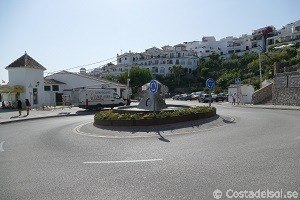 |
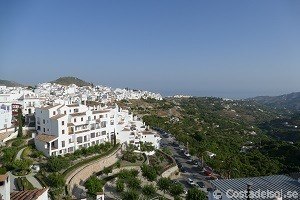 |
Two parts of the city
The village can be divided into two parts: one is the older Morisco-Mudejar part of town, with Morisco and medieval origins. The other is the newer lower part, where the architectural style of the old village has been imitated. Between the old and the new parts are two old buildings.
One is the old grain store that was built in 1767 and a Renaissance palace from the 16th century that is now a molasses factory. Above the old part of town are the remains of a Morisco castle and in the center of the village is the church of San Antonio. The main street in the old part of town is Calle Real. It starts its winding journey on narrow cobblestone streets from the sugarcane factory and through the old town until you reach the olive processing plant.
There is also a newer wider road that goes around the village and has parking on both sides. El Zacatin street is one of the most beautiful and photographed streets in the village. Streets or squares that used to sell clothing were named this way. Following Calle del Penon will lead you to the top of the hill behind Frigiliana from where you have an incredible view of the whole village and over Nerja and the sea. In the old part of Frigiliana, you can also find mosaics by artist Pilar Garcia Millan adorning the walls and you can get a portrayal of the village’s history.
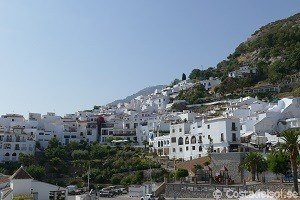 |
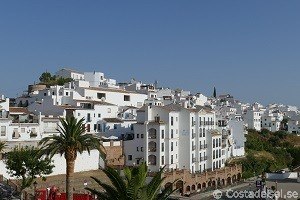 |
Market
On Thursdays, there is a market day in Frigiliana. The market is held in the center of the village on the roof of the new parking building right at the bus stop and the roundabout. Here, you can buy clothes, shoes, food, fruit, vegetables, etc. Some Saturdays, there are also art and craft markets.
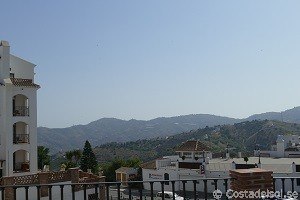 |
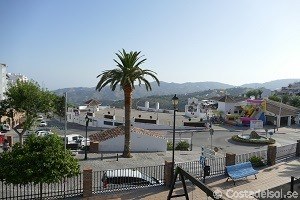 |
Food
In Frigiliana, you can find typical local dishes such as almond-sauced chicken made with locally produced almonds, various soups, stews made with fresh and local vegetables, migas which is a mixture of bread crumbs and fried bread. In cooking, they also use local olive oils, nutmeg grapes, and miel de cana which is a molasses made from locally grown sugar cane, cabbage, fennel, etc. At Easter, they also make a stew of salted cod, which is served with pancakes made with sugar cane molasses.
Another specialty is dishes made with choto or kid, with fried or boiled garlic and various sauces. In cooking, they use locally produced products such as sugar cane, virgin oil, nutmeg grapes, almonds, vegetables, etc. The local drink is Moscatel wine, which can range from very dry to very sweet. You can see olives and grapes growing in terraces on the hills, which are then used to produce wines.
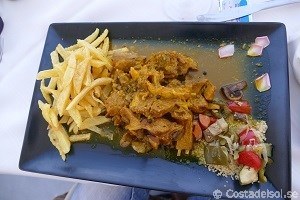 |
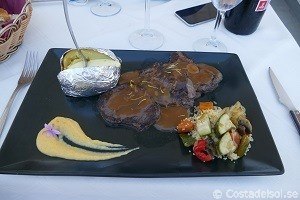 |
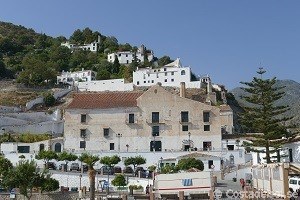 |
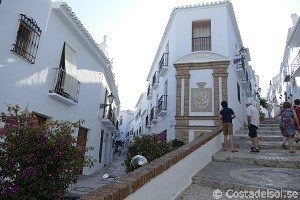 |
Sights
Solariega House of the Counts/The Ingenio
This house was built at the end of the 17th century by the Manrique de Lara family, who were the nobility of Frigiliana. The house is in Renaissance style, where the architectural features were collected from the destroyed Arab castle. For example, balconies, wrought iron, wall paintings, etc. The building stands on two thousand square meters of land and a sugar cane plantation was established here and a sugar factory. There is still a molasses factory in this building, which is the last of its kind in Europe. The factory is called Ingenio Nuestra Senora del Carmen.
Fuente Vieja
Fuente Vieja is an old fountain from the 17th century. The fountain was built by Don Inigo Manrique de Lara, at the back of a house to provide water to the village and to the animals. If you walk through the old town, you will find this fountain on the street Choruelo. The fountain has originally been known as “The new Fountain”.
El Torreon
El Torreon is located in the old Mudejar district outside Calle Real street. It was previously a grain storage but is now part of a house. It is not believed to be from the Arab era as it does not resemble the architectural style of that time. It is likely to be a construction from the 17th century and the building may have been a watchtower against pirates. The courtyard can be found by walking through a building with multiple arches with signs saying “El Torreon”.
El Castillo
This castle was likely built in the 11th century and was used as a military fortress. The castle covered an area of 4,000 m2 and was located on top of the village. There is now almost nothing left of the castle. The castle was destroyed in the battle of Frigiliana when the Moors were driven out. From here you have an incredible view of the countryside.
House of the Apero
The House of the Apero houses the tourist office, the city library, all the historical archives of Frigiliana and the historical museum. Here is the first archaeological museum in Axarquia. The building was built in the early seventeenth century.
The Chapel of Ecce Homo
The Chapel of Ecce Homo is known locally as the Chapel of Holy Christ of Sugar Cane. This place has a great cultural interest and Easter festivities are celebrated here. From the 16th century, processions were held through the streets with depictions of the Christian faith. But today there are depictions from the Neo-Baroque period of the 20th century. On Ash Wednesday, a procession is held from the chapel to the Church of San Antonio where there is a multicolored wooden altarpiece in the Neo-Baroque style.
The Church of San Antonio de Padua
The church was built in 1976 where a mosque had previously stood. A century later, it was restored by Manrique de Lara and completed in 1676 by Benardo de Godoy. Almost the entire building is built in Renaissance style and there are three 17th century paintings of good quality on display. The construction of the building can also be read about on a plaque at the entrance.
Royal Silos (Reales Positas)
The silos were built in 1767 and surplus grain was stored there during good years, to be used in the years when grain production was poor. The silos have now been replaced by privately owned houses, preserving the original structure of the red brick vaulted facade and the cellars underneath.
Barrio Mudejar (Moriska kvarteren)
I gamla stan i Frigiliana hittar men de moriska kvarteren som är ett speciellt monument i och med att det har klassificerats som det bästa exemplet på en arkitektonisk ensemble av byggnader av arabiskt ursprung. Det är väldigt tydligt i Frigilianas arkitektur att araberna har haft ett stort inflytande på byn.
Tiled Panels
Throughout the old town, you can also find twelve tiled panels. They depict the famous Battle of Frigiliana, which marked the end of the presence of Moors on the Iberian Peninsula, and the battles that were fought in the area.
Artists and Photographers
Many artists and photographers have been drawn to the old part of Frigiliana. For example, Arne Haugen Sorensen, Klaus Hinkel, Penelope Wurr, Miro Slavin, etc. Regular exhibitions are held in private galleries around the area and also in Casa del Apero.
Pozo Batan Alberca
Pozo Batan Alberca is Frigiliana’s natural pool. Swimming is officially not allowed here, but the local people sometimes swim here when it gets very hot.
Hiking
Hiking in a river bed and ravine up to the mountain town of Frigiliana is very popular. You get to experience beautiful nature with flowers and excitement at various passages. It takes 2 hours to complete this hike. After arriving in Frigiliana, you can take a walking tour of the town.
 |
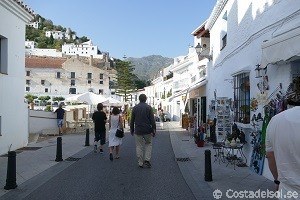 |
Fiestas
The Tres Culturas cultural festival, the largest event in Frigiliana, is celebrated during the last week of August. On January 20, Frigiliana celebrates its patron saint San Sebastian. The local festival or feria is held on June 13th.
Getting There
Frigiliana is located about 6 km above Nerja. Take the A7/E15 road until you reach exit 292 towards Nerja and Frigiliana. In the roundabout, take the left, and in the next roundabout take the straight road, then choose MA-5105 towards the mountains. This is a single road that winds its way to the mountain until you reach Frigiliana. In Frigiliana, there is a large parking garage where it is best to park. It is then better to walk around the town as several roads are car-free. You can also choose to take a bus from Nerja to Frigiliana, or take a taxi from Nerja to Frigiliana.
Economy
In Frigiliana, the main economic activity was the production of silk, olives and its derivatives, grapes and figs. However, with the expulsion of the Moors, silk production was abandoned, and instead, sugarcane cultivation became the main economic activity. This is seen with the El Ingenio building still standing as the only remaining sugar factory in Europe and it is still in production.
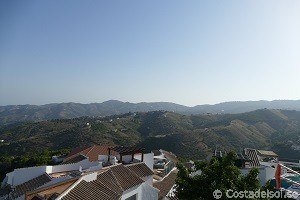 |
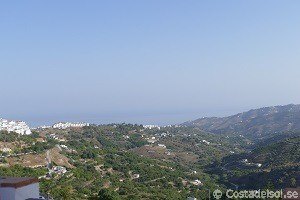 |

